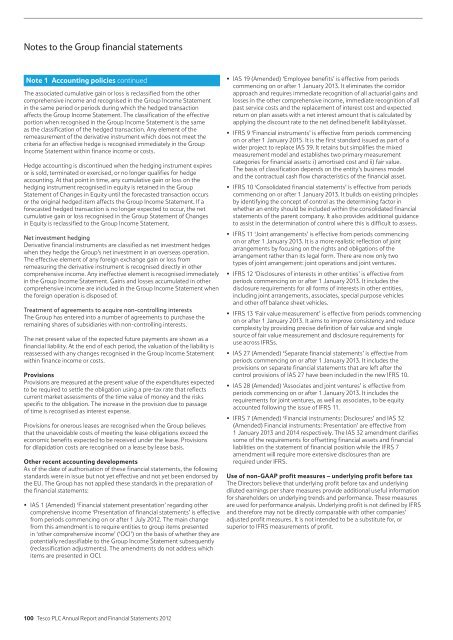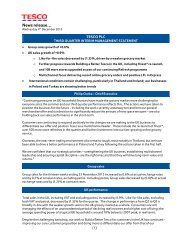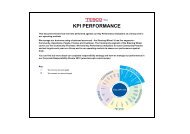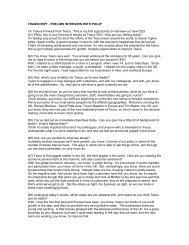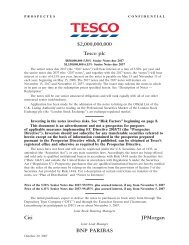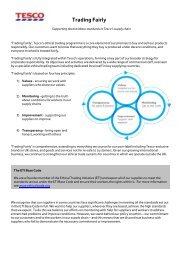Tesco plc Annual Report and Financial Statements 2012
Tesco plc Annual Report and Financial Statements 2012
Tesco plc Annual Report and Financial Statements 2012
You also want an ePaper? Increase the reach of your titles
YUMPU automatically turns print PDFs into web optimized ePapers that Google loves.
Notes to the Group financial statements<br />
Note 1 Accounting policies continued<br />
The associated cumulative gain or loss is reclassified from the other<br />
comprehensive income <strong>and</strong> recognised in the Group Income Statement<br />
in the same period or periods during which the hedged transaction<br />
affects the Group Income Statement. The classification of the effective<br />
portion when recognised in the Group Income Statement is the same<br />
as the classification of the hedged transaction. Any element of the<br />
remeasurement of the derivative instrument which does not meet the<br />
criteria for an effective hedge is recognised immediately in the Group<br />
Income Statement within finance income or costs.<br />
Hedge accounting is discontinued when the hedging instrument expires<br />
or is sold, terminated or exercised, or no longer qualifies for hedge<br />
accounting. At that point in time, any cumulative gain or loss on the<br />
hedging instrument recognised in equity is retained in the Group<br />
Statement of Changes in Equity until the forecasted transaction occurs<br />
or the original hedged item affects the Group Income Statement. If a<br />
forecasted hedged transaction is no longer expected to occur, the net<br />
cumulative gain or loss recognised in the Group Statement of Changes<br />
in Equity is reclassified to the Group Income Statement.<br />
Net investment hedging<br />
Derivative financial instruments are classified as net investment hedges<br />
when they hedge the Group’s net investment in an overseas operation.<br />
The effective element of any foreign exchange gain or loss from<br />
remeasuring the derivative instrument is recognised directly in other<br />
comprehensive income. Any ineffective element is recognised immediately<br />
in the Group Income Statement. Gains <strong>and</strong> losses accumulated in other<br />
comprehensive income are included in the Group Income Statement when<br />
the foreign operation is disposed of.<br />
Treatment of agreements to acquire non-controlling interests<br />
The Group has entered into a number of agreements to purchase the<br />
remaining shares of subsidiaries with non-controlling interests.<br />
The net present value of the expected future payments are shown as a<br />
financial liability. At the end of each period, the valuation of the liability is<br />
reassessed with any changes recognised in the Group Income Statement<br />
within finance income or costs.<br />
Provisions<br />
Provisions are measured at the present value of the expenditures expected<br />
to be required to settle the obligation using a pre-tax rate that reflects<br />
current market assessments of the time value of money <strong>and</strong> the risks<br />
specific to the obligation. The increase in the provision due to passage<br />
of time is recognised as interest expense.<br />
Provisions for onerous leases are recognised when the Group believes<br />
that the unavoidable costs of meeting the lease obligations exceed the<br />
economic benefits expected to be received under the lease. Provisions<br />
for dilapidation costs are recognised on a lease by lease basis.<br />
Other recent accounting developments<br />
As of the date of authorisation of these financial statements, the following<br />
st<strong>and</strong>ards were in issue but not yet effective <strong>and</strong> not yet been endorsed by<br />
the EU. The Group has not applied these st<strong>and</strong>ards in the preparation of<br />
the financial statements:<br />
�� IAS 1 (Amended) ‘<strong>Financial</strong> statement presentation’ regarding other<br />
comprehensive income ‘Presentation of financial statements’ is effective<br />
from periods commencing on or after 1 July <strong>2012</strong>. The main change<br />
from this amendment is to require entities to group items presented<br />
in ‘other comprehensive income’ (‘OCI’) on the basis of whether they are<br />
potentially reclassifiable to the Group Income Statement subsequently<br />
(reclassification adjustments). The amendments do not address which<br />
items are presented in OCI.<br />
100 <strong>Tesco</strong> PLC <strong>Annual</strong> <strong>Report</strong> <strong>and</strong> <strong>Financial</strong> <strong>Statements</strong> <strong>2012</strong><br />
�� IAS 19 (Amended) ‘Employee benefits’ is effective from periods<br />
commencing on or after 1 January 2013. It eliminates the corridor<br />
approach <strong>and</strong> requires immediate recognition of all actuarial gains <strong>and</strong><br />
losses in the other comprehensive income, immediate recognition of all<br />
past service costs <strong>and</strong> the replacement of interest cost <strong>and</strong> expected<br />
return on plan assets with a net interest amount that is calculated by<br />
applying the discount rate to the net defined benefit liability/asset.<br />
�� IFRS 9 ‘<strong>Financial</strong> instruments’ is effective from periods commencing<br />
on or after 1 January 2015. It is the first st<strong>and</strong>ard issued as part of a<br />
wider project to replace IAS 39. It retains but simplifies the mixed<br />
measurement model <strong>and</strong> establishes two primary measurement<br />
categories for financial assets: i) amortised cost <strong>and</strong> ii) fair value.<br />
The basis of classification depends on the entity’s business model<br />
<strong>and</strong> the contractual cash flow characteristics of the financial asset.<br />
�� IFRS 10 ‘Consolidated financial statements’ is effective from periods<br />
commencing on or after 1 January 2013. It builds on existing principles<br />
by identifying the concept of control as the determining factor in<br />
whether an entity should be included within the consolidated financial<br />
statements of the parent company. It also provides additional guidance<br />
to assist in the determination of control where this is difficult to assess.<br />
�� IFRS 11 ‘Joint arrangements’ is effective from periods commencing<br />
on or after 1 January 2013. It is a more realistic reflection of joint<br />
arrangements by focusing on the rights <strong>and</strong> obligations of the<br />
arrangement rather than its legal form. There are now only two<br />
types of joint arrangement: joint operations <strong>and</strong> joint ventures.<br />
�� IFRS 12 ‘Disclosures of interests in other entities’ is effective from<br />
periods commencing on or after 1 January 2013. It includes the<br />
disclosure requirements for all forms of interests in other entities,<br />
including joint arrangements, associates, special purpose vehicles<br />
<strong>and</strong> other off balance sheet vehicles.<br />
�� IFRS 13 ‘Fair value measurement’ is effective from periods commencing<br />
on or after 1 January 2013. It aims to improve consistency <strong>and</strong> reduce<br />
complexity by providing precise definition of fair value <strong>and</strong> single<br />
source of fair value measurement <strong>and</strong> disclosure requirements for<br />
use across IFRSs.<br />
�� IAS 27 (Amended) ‘Separate financial statements’ is effective from<br />
periods commencing on or after 1 January 2013. It includes the<br />
provisions on separate financial statements that are left after the<br />
control provisions of IAS 27 have been included in the new IFRS 10.<br />
�� IAS 28 (Amended) ‘Associates <strong>and</strong> joint ventures’ is effective from<br />
periods commencing on or after 1 January 2013. It includes the<br />
requirements for joint ventures, as well as associates, to be equity<br />
accounted following the issue of IFRS 11.<br />
�� IFRS 7 (Amended) ‘<strong>Financial</strong> instruments: Disclosures’ <strong>and</strong> IAS 32<br />
(Amended) <strong>Financial</strong> instruments: Presentation’ are effective from<br />
1 January 2013 <strong>and</strong> 2014 respectively. The IAS 32 amendment clarifies<br />
some of the requirements for offsetting financial assets <strong>and</strong> financial<br />
liabilities on the statement of financial position while the IFRS 7<br />
amendment will require more extensive disclosures than are<br />
required under IFRS.<br />
Use of non-GAAP profit measures – underlying profit before tax<br />
The Directors believe that underlying profit before tax <strong>and</strong> underlying<br />
diluted earnings per share measures provide additional useful information<br />
for shareholders on underlying trends <strong>and</strong> performance. These measures<br />
are used for performance analysis. Underlying profit is not defined by IFRS<br />
<strong>and</strong> therefore may not be directly comparable with other companies’<br />
adjusted profit measures. It is not intended to be a substitute for, or<br />
superior to IFRS measurements of profit.


